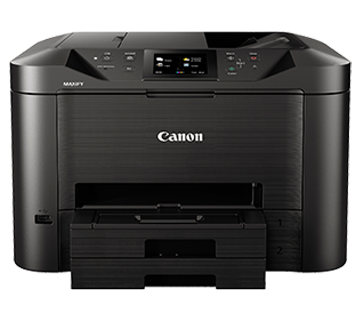MAXIFY MB5470


Print Head/Consumables |
|
Number of Nozzles |
Total 4,352 nozzles |
Ink Cartridges (Type/Colours) |
PGI-2700 (Pigment Ink/Black, Cyan, Magenta, Yellow)
|
Maximum Print Resolution |
600 (Horizontal) x 1,200 (Vertical) dpi |
Print Speed*1 (Approx.) Click here for summary report
|
|
Document (ESAT/Simplex) |
24 / 15.5 ipm (Mono/Colour) |
Document (Max.) |
32.5 / 26.5 ppm*2 (Mono/Colour) |
Document (ESAT/Duplex) |
13 / 9.5 ipm (Mono/Colour) |
Document (FPOT Ready/Simplex) |
6 / 7 sec (Mono/Colour) |
Document (FPOT Sleep/Simplex) |
10 / 12 sec (Mono/Colour) |
Print Width |
Up to 203.2 mm (8") |
Recommended Printing Area |
Top margin: 45.8 mm
|
Scanner Type |
Flatbed (ADF/Platen) |
Scanner Technology |
Contact Image Sensor (CIS) x2 (2-Sided) |
Duplex Scanning |
Available (Single pass, 2-sided scan) |
Optical Resolution*4 |
1,200 x 1,200 dpi |
Scanning Bit Depth (Input/Output) |
|
Greyscale |
16 bit / 8 bit |
Colour |
48 bit / 24 bit (RGB each 16 bit / 8 bit) |
Scanning Speed*5 *6 (Approx.) |
|
Document (ADF) (scESAT30secA/Simplex) |
19 / 16 ipm (Mono/Colour) |
Document (ADF) (scESAT30secA/Duplex) |
23 ipm (Mono/Colour) |
Document (ADF) (scEFTP30secF/Simplex) |
17.5 / 15 ipm (Mono/Colour) |
Document (ADF) (scEFTP30secF/Duplex) |
21.5 / 21 ipm (Mono/Colour) |
Maximum Document Size |
|
Flatbed |
A4, LTR (216 x 297 mm) |
ADF |
A4, LTR, LGL |
Copy Speed*7 (Approx.) Click here for summary report
|
|
Document (sFCOT/Simplex) |
11 sec (Colour) |
Document (ADF) (ESAT/Simplex) |
22 / 11.5 ipm (Mono/Colour) |
Document (ADF) (ESAT/Duplex) |
10 / 6 ipm (Mono/Colour) |
Maximum Copies |
99 pages |
Maximum Document Size |
|
Flatbed |
A4, LTR |
ADF |
A4, LTR, LGL |
Reduction/Enlargement |
25 - 400% |
Copy Features |
Two-sided, Collate, 2-on-1, 4-on-1, Frame Erase, ID Copy |
Type |
Desktop Transceiver (Super G3/Colour Communication) |
Transmission Speed*8 |
|
Mono |
3 sec |
Colour |
1 min |
Modem Speed |
Max. 33.6 kbps (Automatic fall back) |
Compression |
|
Mono |
MH, MR, MMR |
Colour |
JPEG |
Gradation |
|
Mono |
256 levels |
Colour |
24-bit Full Colour (RGB each 8-bit) |
ECM (Error Correction Mode) |
ITU-T T.30 compatible |
Automatic Dialling |
|
Coded Speed Dialing |
Max. 100 locations |
Group Dialling |
Max. 99 locations |
Transmission/Reception Memory*9 |
Approx. 250 pages |
Type |
Windows, macOS |
Mono/Colour |
B/W Transmission only |
Print Margin |
|
Bordered Printing |
LTR, LGL:
|
Bordered Auto Duplex Printing |
LTR, LGL:
|
Supported Media |
|
Cassette |
Plain Paper (64 - 105 g/m²)
|
Auto 2-Sided Printing
|
A4, LTR |
Paper Size |
|
Cassette |
A4, A5, B5, LTR, LGL, B-Oficio*10, M-Oficio, Foolscap, LGL (India) Executive, Envelope (COM10, DL, C5, Monarch), 4 x 6", 5 x 7", 7 x 10", 8 x 10"
|
Auto 2-Sided Printing
|
A4, LTR |
Maximum Capacity |
|
Cassette 1 (Upper) |
Plain Paper, 64 g/m² (A4, A5, B5, LTR, LGL): 250
|
Cassette 2 (Lower) |
Plain Paper, 64 g/m² (A4, LTR, LGL): 250 |
Auto Document Feeder |
Plain Paper (A4, LTR): 50
|
Paper Weight |
|
Cassette 1 (Upper) |
Plain Paper: 64 - 105 g/m²
|
Cassette 2 (Upper) |
Plain Paper: 64 - 105 g/m² |
Protocol |
SNMP (Standard MIB), TCP/IP |
Wired LAN |
|
Type |
IEEE802.3u (100BASE-TX) / IEEE802.3 (10BASE-T) |
Wireless LAN |
|
Type |
IEEE802.11b/g/n
|
Security |
WEP 64/128 bit
|
Direct Connection (Wireless LAN) |
Available |
Canon Printing Apps |
|
Mobile |
Canon PRINT, Easy-PhotoPrint Editor |
Others |
Easy-Layout Editor, PosterArtist Lite, PosterArtist (Web) |
Mobile/Cloud Printing Solutions |
AirPrint®, Mopria® Print Service, Canon Print Service (Android), Cloud Integration Service |
OS System Compatibility*12 |
Windows 10 / 8 / 7 SP1 / Windows Vista SP2, |
Operation Panel |
|
Display |
3.5" LCD (Touchscreen, Colour) |
Interface |
USB 2.0, USB Flash Memory |
Operating Environment*13 |
|
Temperature |
5 - 35°C |
Humidity |
10 - 90% RH (no dew condensation) |
Recommended Environment*14 |
|
Temperature |
15 - 30°C |
Humidity |
10 - 80% RH (no dew condensation) |
Storage Environment |
|
Temperature |
0 - 40°C |
Humidity |
5 - 95% RH (no dew condensation) |
Quiet Mode |
Available |
Acoustic Noise*15 |
|
Plain Paper (A4, Mono) |
56 dB(A) |
Power Requirements |
AC 100 - 240 V, 50/60 Hz |
Power Consumption (Approx.) |
|
OFF |
0.3 W |
Standby |
0.9 W |
Operation*16 |
27 W |
Duty Cycle |
Up to 30,000 pages/month |
Dimensions (W x D x H) |
|
Factory Configuration |
463 x 394 x 351 mm |
Paper Installed (A4/LTR) |
463 x 459 x 351 mm |
Output/ADF Trays Extended |
463 x 607 x 389 mm |
Weight |
12.9 kg |
Plain Paper
|
A4 Colour Documents*18:
|
Disclaimer